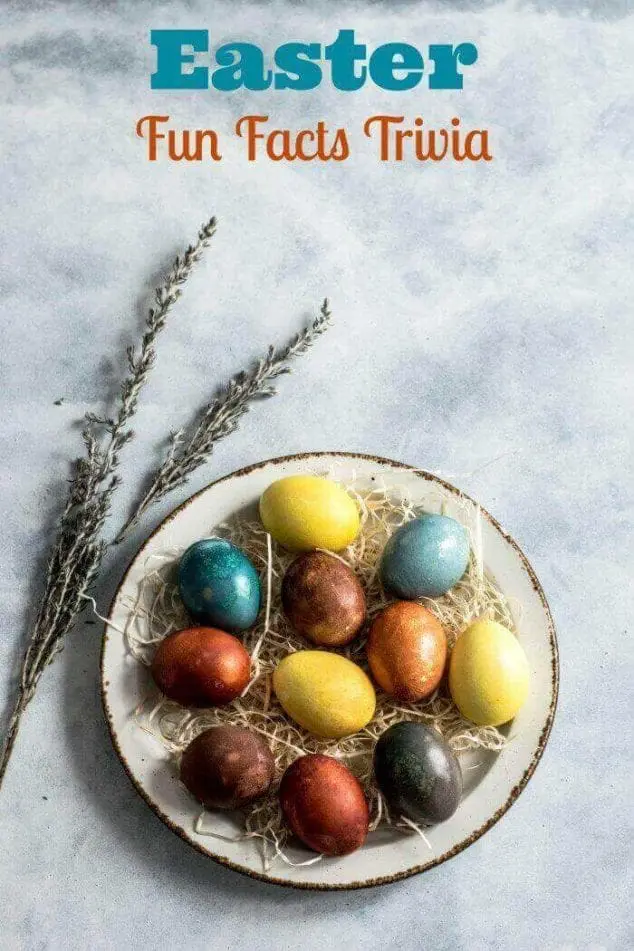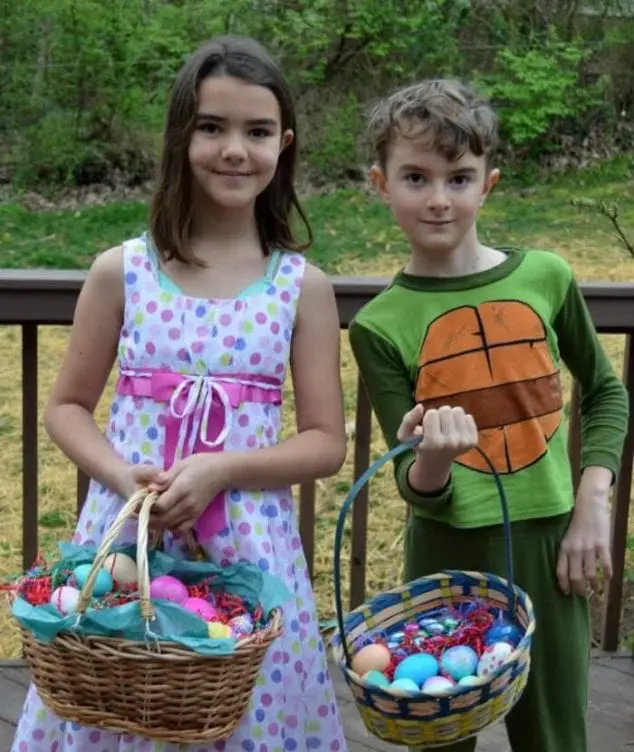Many beloved Easter traditions have been celebrated for centuries. However, you won’t find them mentioned in the Bible. So, where do Easter traditions come from? The history behind Easter Traditions is really interesting and makes for entertaining Easter facts and trivia. The Easter bunny, for instance, was reportedly introduced to America by German immigrants who shared stories of an egg-laying bunny when they arrived in their new homeland. Decorating Easter eggs is believed to date back to at least the 13th century. The ever-popular Easter parade has even older roots. Read on to learn more about the origins of Easter Traditions and brush up on cool Easter trivia facts.

Do You Know Your Easter Facts And Trivia?
Often when Easter is thought of, two different things seem to come to mind- the Easter bunny and the resurrection of Christ. One naturally wonders how those are connected, if at all. Here are some of the most popular Easter traditions along with the history behind them. I hope you enjoy sharing this Easter Trivia with your kids! These Easter fun facts are great conversations starters and can be fun to talk about while you make Easter crafts together.
The Origins Of Easter Traditions

Let’s take a closer look at the history of Easter. Here are some fun Easter facts which I have broken down by category to help you get excited for the Easter season.
ORIGIN OF EASTER BUNNY TRADITION
Probably the most recognizable Easter holiday tradition is that of the Easter Bunny. The exact origins of Easter bunnies are unclear, but rabbits are an ancient symbol of new life. The Easter bunny first arrived in the United States in the 1700s with German immigrants who brought their Easter bunny tradition with them across the ocean. Their children made nests for the bunny to lay its colored eggs. Eventually, the custom began to spread. The fabled rabbit’s Easter morning deliveries began to include chocolate bunnies, candy and gifts in baskets decorated with fake grass to look like nests.
ABOUT THE EASTER CANDY TRADITION
Easter is the second best-selling candy holiday in the U.S, right after Halloween. The most popular items include chocolate eggs, which date back to the early 19th century in Europe. Eggs have long been associated with Easter as a symbol of new life and Jesus’ resurrection. The jelly bean, an egg-shaped candy, was first associated with Easter in the 1930s. Over 16 billion jelly beans are made in America every year for Easter, according to the National Confectioners Association. That’s enough to fill a giant egg measuring 89 feet high and 60 feet wide.
One of the most popular, and most recognized, Easter treat is the Peep. Marshmallow peeps are made by Just Born, a candy manufacturing company in Bethlehem, Pennsylvania. It was founded by Russian immigrant Sam Born in 1923. Peeps first hit the market in the 1950s.
ORIGIN OF THE EASTER PARADE TRADITION
In New York City, the annual Easter Parade tradition dates back to the mid-1800s. Aristocrats would attend services at various Fifth Avenue churches then go for a stroll after services to show off their new spring outfits and hats. People of all walks of life started coming out to watch up and down Fifth Avenue.
The tradition even become a film in 1948, Easter Parade, starring Fred Astaire and Judy Garland with the music of Irving Berlin. The title song includes the lyrics: “In your Easter bonnet, with all the frills upon it/You’ll be the grandest lady in the Easter parade.”
The Easter Parade is still an annual tradition in Manhattan, and Fifth Avenue from 49th Street to 57th Street is shut down to traffic for the it. Many cities and towns across the country have picked up this tradition and started their own annual Easter Parades.
HOW DID THE TRADITION OF EASTER EGGS START?
Decorating eggs for Easter is a tradition that dates back to the 13th century. One explanation for the tradition is that eggs used to be a forbidden food for the duration of Lent (aka the Lenten season). People would hand paint eggs to mark the end of the penance and fasting period; then eat them on Easter as a celebration.

ORIGIN OF THE EASTER EGG HUNT
Easter egg hunts and rolls are somewhat popular traditions. The annual White House Easter Egg Roll across the White House lawn happens on the Monday after Easter. The first official White House egg roll was in 1878, when Rutherford B. Hayes was president. While the event has no religious origin significance, some consider egg rolling to be symbolic. The rolling of the egg can be seen as the rolling away of the stone blocking Jesus’ tomb during his resurrection. We love the Easter Egg Hunt!
Bible Trivia About Easter
I don’t think this list of Easter trivia facts would be complete without sharing some Bible trivia about Easter Sunday. Easter is a Christian holiday celebrating the resurrection of Jesus Christ. In fact, the previous Sunday is known as Palm Sunday and the week leading up to Easter Sunday is known as the holy week. Religious observation includes recognizing Maundy Thursday in commemoration of the Last Supper. Good Friday marks the day that Jesus died on the cross to save us from our sins. Hot cross buns are a way that some recognize the significance of Christ being crucified on the cross. Holy Saturday (or Lazarus Saturday for Eastern Orthodox churches) includes the start of the Easter Vigil for many churches. You can celebrate with a traditional Easter hymn such as Christ the Lord is Risen Today.
While easter is primarily a religious holiday, churches often put on special events to entertain all churchgoers. This is especially true for easter services, which can be quite long. To keep everyone entertained, churches often put on special easter-themed events such as easter egg hunts, easter basket raffles, or even easter talent shows. By offering these unique easter church service ideas, churches can ensure that everyone has a fun and memorable easter experience.
Bonus Easter Trivia Questions And Answers
- Question: What famous candy was first introduced for Easter in 1962? Answer: Cadbury Creme Eggs.
- Question: What flower is often associated with Easter? Answer: The Easter Lily.
- Question: Which country is said to have originated the tradition of the Easter Bunny? Answer: Germany.
- Question: What does the term “Paschal” mean in relation to Easter? Answer: It refers to the Passover and is derived from the Latin word “Pascha” and the Hebrew word “Pesach.”
- Question: What is the name of the week leading up to Easter Sunday? Answer: Holy Week.
- Question: What is the traditional meat served for Easter Sunday dinner in many households? Answer: Ham Or Lamb.
Conclusion
I hope you enjoyed learning these fun facts about Easter. From the first easter eggs to the first easter egg roll, the round-up of facts is quite informative. I bet there were several Easter facts here you didn’t know already about the origin of Easter traditions. There are so many interesting facts about Easter and it is a great way to interest kids in history and discuss geography as well!
Had you thought about the origins of Easter Traditions before? As Easter approaches, take some time to think about your family’s Easter traditions, what they mean, and how they got started. Maybe you’ll be inspired to start some new traditions this Easter! What is your favorite Easter Tradition? Which of these Easter fun facts and trivia were you most surprised to learn?
Related Posts:
DIY Easter Decorating Ideas To Bring Cheer To Your Home

Katerina says
This Easter trivia for kids is so interesting and fun to find out! Thanks so much for sharing about the story behind the first Easter baskets! Here is another fun fact (from the Guinness Book)- “The largest Easter egg hunt consisted of 501,000 eggs that were searched for by 9,753 children accompanied by their parents at the Cypress Gardens Adventure Park in Winter Haven, Florida, USA, on 1 April 2007.” Talk about an Easter celebration!
Riki Krisdianto says
Here’s a Easter Bible trivia question for you:
Which gospel records the most details about the resurrection of Jesus?
The answer is the Gospel of John. It provides the most detailed account of the events surrounding Jesus’ resurrection, including interactions with Mary Magdalene, Thomas, and the miraculous catch of fish.
Lexie says
I have just been searching for information on the idea of the easter bunny and yours is the best I have found so far. It is interesting to learn the roots of American popular culture as it relates to Easter time celebrations
Eva says
Here’s some fun chocolate bunny trivia for you:
The first chocolate bunnies were made in Germany in the 1800s.
Americans buy more than 90 million chocolate bunnies during Easter each year.